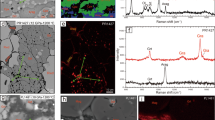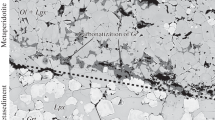Abstract
Carbonates are potentially significant hosts for primordial and subducted carbon in the Earth's mantle. In addition, the coexistence of carbonate with silicates and reduced carbon (diamond or graphite), allows constraints to be placed on the oxidation state of the mantle. Carbonate-silicate-vapor reactions control how carbonate + silicate assemblages may form from carbon-bearing vapor + silicate assemblages with increasing pressure. In olivine-bearing rocks such as peridotite, considered the dominant rock type in the upper mantle, the lowest-pressure carbonate-forming reactions involve olivine (±clinopyroxene) reacting with CO2 (e.g., Wyllie et al. 1983). In eclogitic rocks, the essential mineral assemblage is omphacitic clinopyroxene + garnet, without olivine. Therefore, alternative carbonate-forming reactions must be sought. The carbonation of clinopyroxene via the reaction dolomite + 2 coesite = diopside + 2 CO2 was studied experimentally by Luth (1995). The alternative possibility that garnet reacts with CO2 is explored here by determining the location of the reaction 3 magnesite + kyanite + 2 coesite = pyrope + 3 CO2 between 5 and 11 GPa in multi-anvil apparatus. At the temperatures ≥1200 °C, carbonation of eclogitic rocks with increasing pressure will proceed initially by reaction with clinopyroxene, because the pyrope-carbonation reaction lies at higher pressures for a given temperature than does the diopside-carbonation reaction. Diluting the pyrope component of garnet and the diopside component of clinopyroxene to levels appropriate for mantle eclogites does not change this conclusion. At lower temperatures, appropriate for “cold” slabs, it is possible that the converse situation will hold, with initial carbonation proceeding via reaction with garnet, but this possibility awaits experimental confirmation. Decarbonation of an eclogite under “normal mantle” geothermal conditions by a decrease in pressure, as in an ascending limb of a mantle convection cell, would be governed by the formation of clinopyroxene + CO2. At higher pressure than this reaction, any CO2 produced by the breakdown of magnesite reacting with kyanite and coesite would react with clinopyroxene to produce dolomite + coesite. Release of CO2 from eclogite into mantle peridotite would form carbonate at sub-solidus conditions and produce a dolomitic carbonate melt if temperatures are above the peridotite-CO2 solidus.
Similar content being viewed by others
Author information
Authors and Affiliations
Additional information
Received: 4 May 1998 / Accepted: 23 December 1998
Rights and permissions
About this article
Cite this article
Knoche, R., Sweeney, R. & Luth, R. Carbonation and decarbonation of eclogites: the role of garnet. Contrib Mineral Petrol 135, 332–339 (1999). https://doi.org/10.1007/s004100050515
Published:
Issue Date:
DOI: https://doi.org/10.1007/s004100050515




